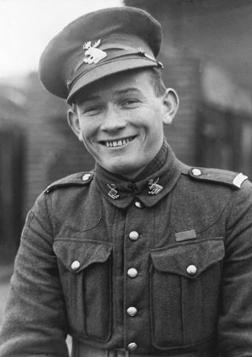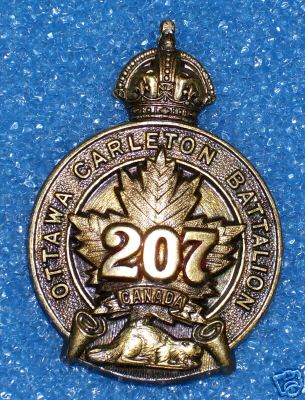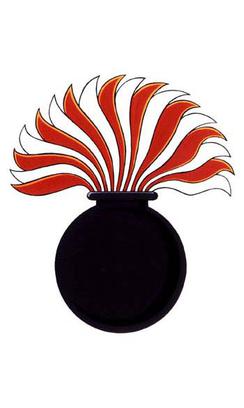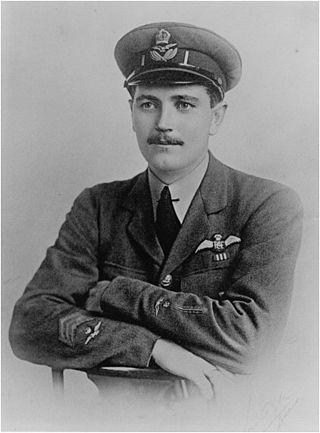Related Research Articles

Sir Samuel Hughes, was the Canadian Minister of Militia and Defence during World War I. He was notable for being the last Liberal-Conservative cabinet minister, until he was dismissed from his cabinet post.

The Royal Canadian Regiment (RCR) is an infantry regiment of the Canadian Army. The regiment consists of four battalions, three in the Regular Force and one in the primary reserve. The RCR is ranked first in the order of precedence amongst Canadian Army infantry regiments, but in a quirk of the rules of seniority, its 4th battalion is ninth.
The Canadian Expeditionary Force (CEF) was the expeditionary field force of Canada during the First World War. It was formed on August 15, 1914 following Britain’s declaration of war on the German Empire, with an initial strength of one infantry division. The division subsequently fought at Ypres on the Western Front, with a newly raised second division reinforcing the committed units to form the Canadian Corps. The CEF and corps was eventually expanded to four infantry divisions, which were all committed to the fighting in France and Belgium along the Western Front. A fifth division was partially raised in 1917, but was broken up in 1918 and used as reinforcements following heavy casualties.

Thomas William Holmes VC was a soldier in the Canadian Expeditionary Force, and was a Canadian recipient of the Victoria Cross, the highest and most prestigious award for gallantry in the face of the enemy that can be awarded to British and Commonwealth forces, during the First World War. Holmes is the youngest Canadian to ever win the Victoria Cross.

The 207th (Carleton) Battalion, CEF was a battalion of the First World War Canadian Expeditionary Force.
The 156th Battalion, CEF was a unit in the Canadian Expeditionary Force during the First World War.
The 215th Battalion, CEF was a unit in the Canadian Expeditionary Force during the First World War.
The 222nd Battalion, CEF was a unit in the Canadian Expeditionary Force during the First World War. Based in Winnipeg, Manitoba, the unit began recruiting in early 1916 throughout the province. After sailing to England in November 1916 onboard the RMS Olympic, the battalion was absorbed into the 19th Reserve Battalion on January 2, 1917. The 222nd Battalion, CEF had one Officer Commanding: Lieut-Col. James Lightfoot.

The Winnipeg Grenadiers was an infantry regiment of the Canadian Army.

Les Fusiliers de Sherbrooke is a Primary Reserve infantry regiment of the Canadian Army. It is based in Sherbrooke, Quebec, with a sub-unit in Granby.

The Bermuda Volunteer Rifle Corps (BVRC) was created in 1894 as a reserve for the Regular Army infantry component of the Bermuda Garrison. Renamed the Bermuda Rifles in 1951, it was amalgamated into the Bermuda Regiment in 1965.

The Royal Lincolnshire Regiment was a line infantry regiment of the British Army raised on 20 June 1685 as the Earl of Bath's Regiment for its first Colonel, John Granville, 1st Earl of Bath. In 1751, it was numbered like most other Army regiments and named the 10th Regiment of Foot. After the Childers Reforms of 1881, it became the Lincolnshire Regiment after the county where it had been recruiting since 1781.

Permanent Active Militia (PAM), also known as Permanent Force (PF), was the proper name of Canada's full-time professional land forces from 1855 to 1940, when it was reorganized into the Canadian Army. PAM was in effect Canada's standing army, consisting of one regular infantry regiment and two cavalry regiments in 1914.

The 38th Battalion, CEF was a unit of the First World War Canadian Expeditionary Force. It was mobilized in Ottawa and recruited in Ottawa, Brockville, Perth, Prescott and Alexandria. An initial draft of five officers and 251 other ranks was sent to England on 24 June 1915. The battalion embarked at Montreal on 1 August 1915, aboard the Caledonian, disembarking in Bermuda on 12 August 1915. Its strength was 35 officers and 959 other ranks. The battalion embarked at Bermuda on 30 May 1916, aboard the Grampian, disembarking in England on 9 June 1916. Its strength was 35 officers and 1001 other ranks. The battalion arrived in France on 13 August 1916, becoming part of the 4th Canadian Division, 12th Canadian Infantry Brigade. It was later reinforced by the 7th Canadian Reserve Battalion. The battalion returned to England on 6 May 1919, arrived in Canada on 13 June 1919, was demobilized in Ottawa on 15 June 1919, and was disbanded by General Order 149 of 15 September 1920.

The 87th Battalion, CEF was a Household Foot Guards infantry unit in the Canadian Expeditionary Force during the First World War.

Harold Leslie Edwards DFC MM was a Canadian World War I flying ace gunner, who in conjunction with his pilots, was officially credited with 21 victories.

Sir Frederick Oscar Warren Loomis, was a Canadian soldier who fought in the First World War.

The Bermuda Garrison was the military establishment maintained on the British Overseas Territory and Imperial fortress of Bermuda by the regular British Army and its local militia and voluntary reserves from 1701 to 1957. The garrison evolved from an independent company, to a company of Royal Garrison Battalion during the American War of Independence, and a steadily growing and diversifying force of artillery and infantry with various supporting corps from the French Revolution onwards. During the American War of Independence, the garrison in Bermuda fell under the military Commander-in-Chief of America. Subsequently, it was part of the Nova Scotia Command until 1868, and was an independent Bermuda Command from then until its closure in 1957.
The 42nd Field Artillery Regiment, RCA is a Canadian Army Reserve artillery regiment based in Pembroke, Ontario. It is part of the 4th Canadian Division's 33 Canadian Brigade Group.
Many British nationals from the United Kingdom or colonies who were resident in Canada during the First World War joined the Canadian Expeditionary Force, which was deployed to the Western Front. A sizeable percentage of Bermuda's volunteers who served in the war joined the CEF or the Royal Canadian Navy (RCN), either because they were resident in Canada already, or because Canada was the nearest and easiest other part of the British Empire and Commonwealth to reach from Bermuda. As the Royal Canadian Regiment, 38th Battalion (Ottawa), CEF, 77th Battalion, CEF, and 163rd Battalion (French-Canadian), CEF, were successively posted to the Bermuda Garrison before proceeding to France, islanders were also able to enlist there. Although the Bermuda Militia Artillery (BMA) and Bermuda Volunteer Rifle Corps (BVRC) both sent contingents to the Western Front, the first would not arrive there until June 1915. By then, many Bermudians had already been serving on the Western Front in the CEF for months. No further contingents were sent to France by the BVRC after 1916, however forty-seven BVRC NCOs and Riflemen (Privates) were permitted to re-enlist in Canada during the course of the war. Although some enlisted in British Army organs in Canada, including the Royal Flying Corps, most joined the Canadian Expeditionary Force. Bermudians in the CEF enlisted under the same terms as Canadians.
References
- ↑ "THIRTY-EIGHTH BATTALION IN BERMUDA – 1932". 1915–1916. Retrieved 2022-07-07– via YouTubeDate on the film is shown incorrectly as "1932"
{{cite web}}: CS1 maint: postscript (link) - ↑ "L. CORPL. SWEENEY". The Royal Gazette. City of Hamilton, Pembroke Parish, Bermuda. 1917-02-22. p. 1.
By the last mail we received a post card from Lance Corporal J. F. Sweeney, stating that he was quite well. Corporal Sweeney, who was an ex-soldier previous to the outbreak of hostilities was for some time employed on the works at Prospect. During the time the 38th. Bn. C.E.F. were stationed here he enlisted in that regiment and is now with them at the front.
- ↑ "RETURNING SOLDIERS". The Royal Gazette. City of Hamilton, Pembroke Parish, Bermuda. 1919-09-09. p. 1.
Last Contingent of Veterans Arrived Home Yesterday.
Now that practically all our soldiers have returned, we have learned the secret of enthusiasm and the art of cheering.
When the_"Caraquet" came alongside yesterday, by far the greatest crowd that has ever assembled to meet returning soldiers (with the exception of the occasion of the home coming of the B.C.R.G.A.) was ready to do the honours.
Front St. was alive with people, the sheds were packed, and to add to the excitement, the road roller chose that particular time to pass by the numerous horses.
Sir Thomas greeted the heroes on behalf of the Colony, a compliment that is appreciated by all, but in addition to this official welcome, quite an unusual number of prominent military men and civilians were present to honour the occasion Sir Thomas Wadson spoke as follows:
Each one was addressed by name in order of military rank, and then followed, as under.
"We greet you right warmly on your return from the battle front where you have taken part in the greatest and most terrible war known to history, where you have aided each in his place in bringing about the complete victory won by Great Britain and her Allies, over an enemy who sought to dominate the world, and crush it under the heel of Prussian Militarism. Happily the designs of the enemy have been frustrated, happily the world is now again at peace and you are able to return, some with decorations on which we congratulate those who have received them, and we congratulate all of you on having thus done your duty faithfully in the cause of freedom and justice, and we cordially welcome you to your homes and kindred."
The returning soldiers were:—lieuts. C. Nelmes, RAF. Late attached to Somerset Light Inf. and F. Paterson. Sergt, Major Morgan and wife, Sergt. Mullin, Sergt Baker, Sergt. Churm, M.M. and wife, Sergt. Madeiros MM. and wife. Pets. J. A. Smith, G. Sullivan, R.C. Wilson, M.M., all of the B.V.R.C., Sergt. Sweeney, 58 Canada, Pte. Fox.
A full account will appear in our Thursday's issue. - ↑ "Private CYRIL MORTON Service Number: 410977". Commonwealth War Graves Commission. Commonwealth War Graves Commission. Retrieved 2022-07-19.
- ↑ "ANOTHER BERMUDA HERO: PRIVATE MORTON KILLED IN ACTION". The Royal Gazette. City of Hamilton, Pembroke, Bermuda. 1916-11-11.
he sad news that Private Cyril Morton was killed in action was received here from the Canadian War Office on Thursday morning and cast a gloom over the whole community. Previous to his enlistment in the 38th Ottawa Battalion, C.RF., this year, he was employed in Mr. Norman Young's hardware store where he was a very ardent worker. He first joined the Signal Section of his regiment, but afterwards entered for training in the Machine Gun Section through which he passed successfully. The late Private Morton, who was nearly 19 years of age was the younger son of Mrs. Morton, of Devonshire. The bereaved mother and the many friends of the gallant young soldier have the heartfelt sympathy of the whole community.
- ↑ Guttadauria, Marie (2016-04-25). "First World War: Artifact W1-11: Private JOSEPH LEROUX, 660756, Canadian Infantry CEF – First World War". Friends of the Canadian War Museum. Friends of the Canadian War Museum. Retrieved 2022-09-10.
On March 31, 1916 at the age of 28, my great-uncle Joseph Leroux born in Bourget, Ontario, travelled to Montreal to enlist and become a First World War soldier in the CEF. He was assigned to the 163rd battalion, a mainly French speaking unit originally "Les Fusilliers de Sherbrooke, Montréal". He did his army training in Bermuda until November then sailed to England and disembarked in December 1916. He was sent to France on May 18, 1917 and was taken on strength of the 22nd battalion (a.k.a. the Van Doos). Unfortunately, a few weeks later on 7 July 1917, he was killed in action in the field. He is buried in the Van Loos British Commonwealth Cemetery, France.
- Meek, John F. Over the Top! The Canadian Infantry in the First World War. Orangeville, Ont.: The Author, 1971.